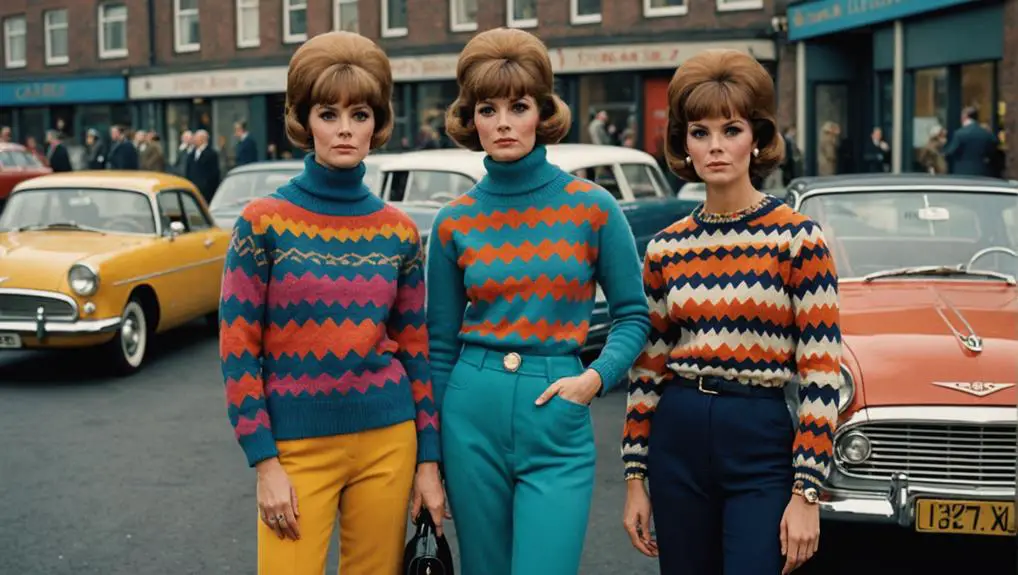In the 1960s, women's jumpers became essential pieces reflecting the era's vibrant spirit and cultural shifts. You'd find cardigans, pullovers, and sweater vests in bold colors, unique patterns, and innovative materials like wool and acrylic blends. This decade emphasized individuality, with designers like Mary Quant pushing the boundaries of style. Jumpers often showcased intricate textures and floral motifs, becoming canvases for self-expression. Sizing varied, accommodating different body types, while vintage pieces could range from $22 to $150 based on uniqueness. To truly appreciate the significance of these jumpers, there's much more to explore about their impact and styling.
Overview of 1960s Fashion
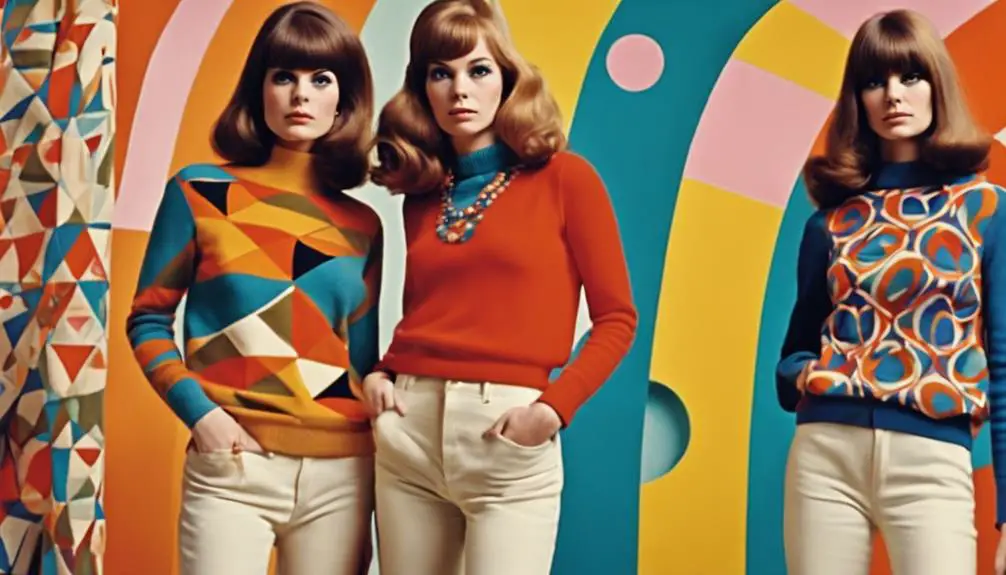
The 1960s fashion scene bursts with creativity, reflecting the dynamic cultural shifts of the decade. As you investigate this era, you'll notice a rich blend of traditional styles and bold, modern designs. The emphasis on individuality and self-expression came alive through vibrant colors and unique patterns in women's knitwear, which often featured distinctive vintage clothing labels that highlighted the craftsmanship of the time. Cardigan sweaters, especially, became a staple, showcasing not just comfort but also a canvas for innovative designs.
Many of these cardigans featured embroidered floral motifs, embodying the spirit of the times. This era embraced craftsmanship and creativity, allowing wearers to express their personalities through their clothing. The incorporation of materials like wool, acrylic, and mohair blends guaranteed these pieces were as functional as they were stylish.
The rise of geometric patterns and intricate embellishments in jumpers further highlighted the decade's avant-garde approach to fashion. Vintage jumpers from the 1960s are now celebrated for their retro aesthetics and craftsmanship, making them highly sought-after by fashion enthusiasts. As you probe deeper into this vibrant period, you'll discover how these garments encapsulated the essence of a transformative era in fashion history.
Popular Styles of Jumpers
Among the standout styles of jumpers in the 1960s, cardigans, pullover sweaters, and sweater vests emerged as favorites, each offering a unique blend of comfort and flair. You'd notice that these knit sweaters featured vibrant colors and eye-catching patterns, reflecting the decade's dynamic spirit. Classic crew neck and mock neck designs were prevalent, with embellishments like floral embroidery and geometric motifs adding visual interest.
During colder months, long sleeve options dominated the scene, while cropped cardigans became staples for casual outings, embodying the youthful vibe of the era. The use of materials such as wool, mohair, and acrylic blends guaranteed that these vintage-inspired garments provided warmth and comfort without sacrificing style.
Many jumpers also showcased retro pin-up and rockabilly designs, incorporating playful elements like bows, anchors, and tattoo art motifs. This eclectic mix allowed you to express individuality while embracing the trends of the time. Overall, the styles of jumpers from the 1960s not only catered to practicality but also served as a canvas for creativity and personal expression, making them timeless pieces in women's fashion.
Iconic Materials and Textures
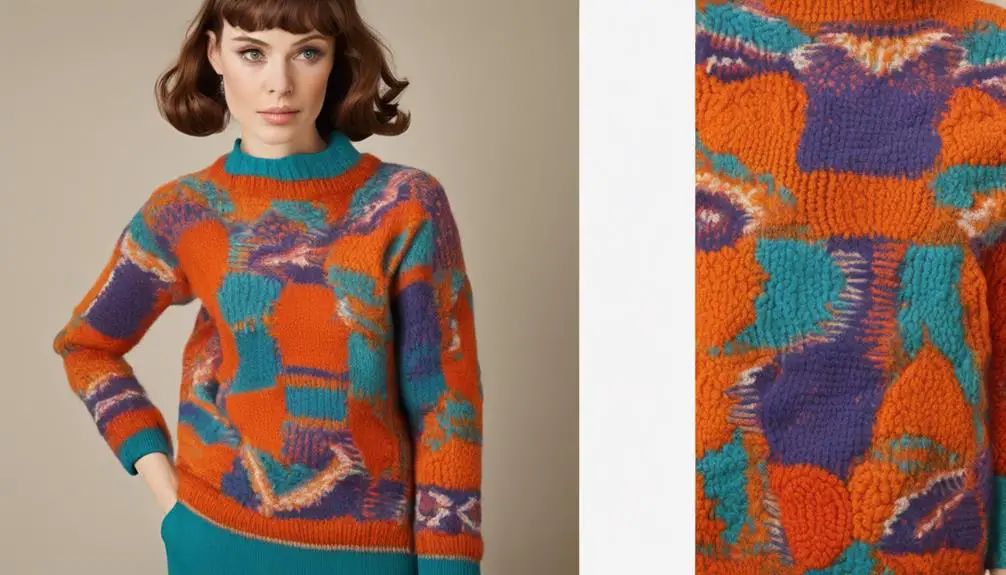
Fashion in the 1960s wasn't just about style; it was also about the materials and textures that defined the era's jumpers. You'd find an array of fabrics that provided warmth while reflecting the vibrant trends of the time. Key materials included wool, cashmere, and mohair blends, but it was the innovative use of lighter fabrics like nylon blends that revolutionized layering.
The textures of these jumpers were equally important, with cable knit styles standing out for their intricate patterns. This craftsmanship not only added depth but also showcased the individuality of each piece. Here's a quick look at some of the iconic materials and textures from that era:
| Material | Texture Features |
|---|---|
| Wool | Warmth and traditional feel |
| Nylon Blend | Lightweight and versatile |
| Cable Knit | Textured patterns and designs |
Moreover, many jumpers incorporated embellishments such as floral embroidery and geometric patterns, enhancing their visual appeal. The combination of these materials and textures made the jumpers of the 1960s not just functional but also a canvas for personal expression.
Influence of Designers and Brands
In the vibrant landscape of 1960s fashion, influential designers and brands played a pivotal role in shaping women's jumpers. Designers like Mary Quant revolutionized knitwear, introducing vibrant colors and styles that resonated with the youthful spirit of the era. Her playful knit cardigans became iconic, reflecting a shift towards more relaxed and expressive fashion. Meanwhile, brands like Courrèges and Pierre Cardin pushed boundaries with their innovative designs, incorporating bold colors and geometric patterns into women's sweaters, making them a canvas for artistic expression.
The rise of prêt-à-porter collections democratized fashion, allowing stylish jumpers to reach a wider audience. This accessibility meant that women could express their individuality through unique knitwear without breaking the bank. Simultaneously, advancements in knitting techniques and materials, particularly acrylic blends, allowed designers to experiment with textures and create playful designs that catered to diverse tastes.
Vintage jumpers from the decade often featured embellishments and motifs that reflected cultural shifts and artistic movements. The influence of these designers and brands not only transformed women's jumpers but also encapsulated the dynamic spirit of the 1960s, making knitwear a significant aspect of women's fashion history.
Size and Fit Considerations
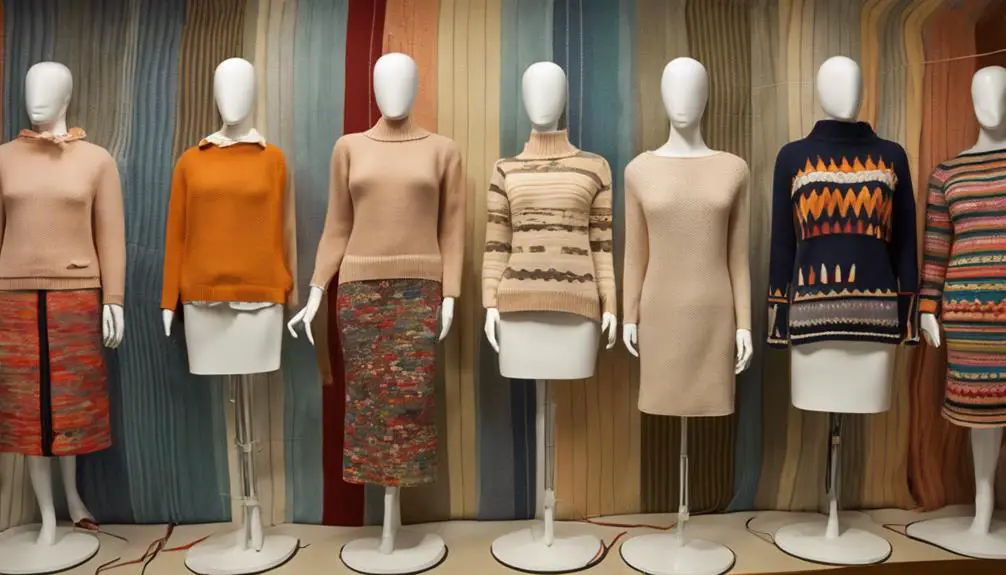
Understanding the importance of size and fit in women's jumpers from the 1960s reveals how these garments were designed to cater to a variety of body types and personal tastes. Sizing during this era ranged from Small to Extra Large, with specific bust measurements often provided to guarantee an accurate fit. However, vintage sizing practices differ from modern standards, making it crucial for you to consult detailed size charts when selecting your 1960s jumpers. Additionally, the presence of vintage clothing labels can offer insights into the era and authenticity of these garments, enhancing your appreciation for their historical context vintage tag insights.
The fit styles of the time varied notably, offering options like boxy, oversized, and tailored designs. This variety meant that you could find a jumper that aligned with your personal style and body shape. Common sleeve lengths included long sleeves and 3/4 sleeves, while some designs featured cropped lengths for a casual flair.
When considering a women's soft jumper with a long sleeve button design, keep in mind that size availability could vary by brand, with some even extending to 3XL. This inclusivity in sizing allowed many women to embrace the fashion trends of the 1960s, allowing that everyone could find something that made them feel stylish and comfortable.
Pricing Trends for Vintage Jumpers
The pricing landscape for vintage women's jumpers from the 1960s showcases a fascinating interplay between design uniqueness and market demand. Typically, you'll find these jumpers priced between $22.00 and $60.00, largely reflecting their distinctive vintage style and quality. Among the popular cardigan styles of the era, prices usually hover around $30.00 to $42.00. However, if you're on the lookout for something special, sequined sweaters can command higher prices, reaching up to $56.00.
For the truly collectible pieces, like the Vintage 1960s Quarter Zip Sweater, prices can soar to about $150.00, often featuring "best offer" options that allow for negotiation. The materials used—wool and acrylic—play a significant role in pricing variations, as condition, craftsmanship, and brand recognition also factor in.
Moreover, it's common to see discounts on select items, making it possible to snag a vintage jumper for less; for instance, a price reduction from $32.00 to $28.80 can be a delightful find. Understanding these trends can help you navigate the market effectively and make informed purchasing decisions.
Care and Maintenance Tips
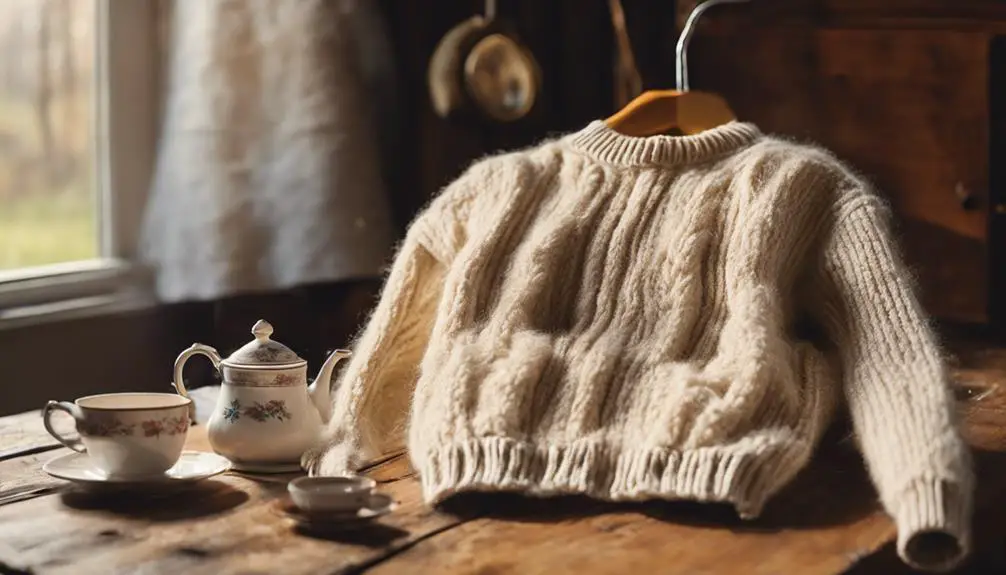
Maintaining the integrity of your vintage 1960s jumpers requires careful attention to their unique needs. Always follow the care label instructions; they often recommend hand washing or dry cleaning to prevent damage, especially for bulky knit fabrics that can easily lose their shape. When storing your jumpers, fold them instead of hanging to avoid stretching. Place acid-free tissue paper inside to help maintain their shape and prevent creasing.
Regularly check for moths or pests, particularly in wool or cashmere blends. Using cedar blocks or lavender sachets can serve as effective natural deterrents. When it comes to washing, opt for a mild detergent specifically designed for delicate fabrics. Avoid bleach and fabric softeners, as these can compromise the vibrant colors and textures of your jumpers.
To keep pilling at bay, gently brush your sweaters with a fabric comb after each use. Be mindful of friction against rough surfaces during wear or storage, as this can lead to unsightly pilling. By following these care and maintenance tips, you can guarantee your vintage jumpers remain in excellent condition for years to come.
Cultural Impact on Fashion
Jumpers in the 1960s weren't just clothing items; they became powerful symbols of the era's cultural transformation. As women's roles evolved, so did their fashion choices, with knit long sleeve jumpers and playful sweater vests reflecting newfound liberation. Influential figures like Twiggy embraced the mod style, popularizing bold patterns and vibrant colors that filled the wardrobes of young women enthusiastic to express their individuality.
The rise of youth culture during this decade brought casual styles to the forefront, catering to the playful spirit of counterculture movements. Designers like Mary Quant and André Courrèges pushed boundaries with innovative materials and daring designs, encouraging women to experiment with their looks. This era's self-expression was palpable, as jumpers became not only fashionable but also a canvas for personal identity.
Music played an important role in shaping jumper fashion, as artists from the British Invasion and folk movements wore unique styles that resonated deeply with the youth. The cultural significance of jumpers in the 1960s is undeniable, marking a profound shift in how women approached fashion, freedom, and their place within society.
How to Style 1960s Jumpers
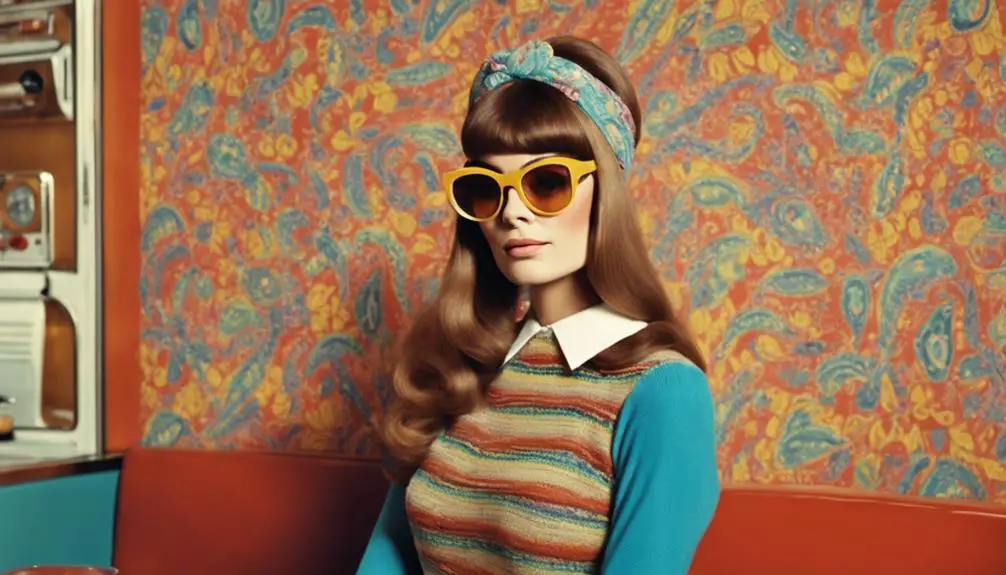
Styling 1960s jumpers offers a unique opportunity to embrace the playful and transformative spirit of the decade while incorporating retro elements into modern wardrobes. To achieve a chic, office-ready look, consider pairing a classic 1960s cardigan with a fitted pencil skirt. This combination emphasizes your waist and adds a touch of elegance. For a casual weekend outfit, layer a sleeveless sweater vest over a fitted turtleneck and high-waisted trousers, creating a stylish yet relaxed ensemble.
To fully embody the era's vibrant essence, opt for a floral embroidered pullover paired with bell-bottom jeans. This look captures the playful spirit while maintaining comfort. If you're aiming for a youthful vibe, a cropped cardigan worn with an a-line mini skirt is perfect for a fun day out.
Don't shy away from mixing textures; a chunky knit sweater can be beautifully balanced with a smooth, flowing maxi skirt. For an added touch of vintage charm, consider a short sleeve Fair Isle jumper that adds warmth and character to your outfit. These styling choices not only honor the 1960s but also allow for personal expression within your contemporary wardrobe.
Frequently Asked Questions
What Was Women's Fashion in the 1960s?
Women's fashion in the 1960s embraced vibrant patterns and bold styles, reflecting cultural shifts. You'd see mini skirts, tailored suits, and playful accessories, encouraging you to express individuality while enjoying comfort and ease in your wardrobe choices.
What Were the Popular Fabrics in the 1960s?
In the 1960s, you'd find a mix of wool, acrylic, and luxurious cashmere dominating fashion. Synthetic fibers like nylon and polyester provided practicality. This blend showcased an evolution in textile preferences, reflecting changing lifestyles and aesthetics.
